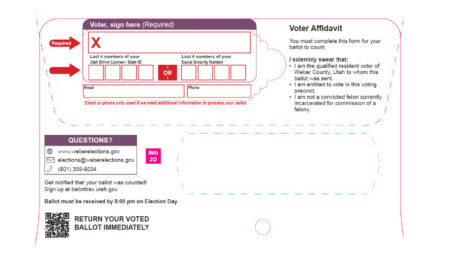Identifying Utah air pollution deaths to spur policy decisions

Benjamin Zack, Standard-Examiner file photo
A pedestrian crosses the 24th Street viaduct in downtown Ogden, where the air pollution made it nearly impossible to see the rest of the city or the surrounding mountains Wednesday, Feb. 10, 2016.Recent scientific studies have further advanced conclusions that Utah’s air pollution is killing people, but that cause of mortality doesn’t show up in the state’s vital statistics.
In an effort to close that loop, Rep. Stephen Handy of Layton is proposing a bill for the 2022 Utah Legislature General Session that would allow physicians to list air pollution as a contributing cause of death on a death certificate.
“If we do this as a policy, then we can get a few years of data going forward to assist in formulating additional policies to reduce air pollution,” said Handy, R-Layton.
Handy said he was prompted by the conclusions of a peer-reviewed study by Brigham Young University, University of Utah, Utah State University and other scientists that was published last year in the academic journal Atmosphere.
The study’s main conclusions were that air pollution shortens the life of the average Utahn by two years; it costs Utah’s economy $1.8 billion a year; fossil fuel pollution causes or worsens many illnesses and conditions in Utah; and many state-level actions are available that would reduce air pollution while benefiting the economy.
Ben Abbott, a BYU assistant professor of ecosystem ecology who was one of nearly two dozen authors of the study, said Tuesday finding more ways to track the deaths “is one of the fundamental challenges in helping us to understand how dangerous air pollution is.”
He said air pollution “is a risk factor that increases the chances of a whole bunch of other things going wrong,” similar to the effects of smoking.
“That means that if somebody dies of stroke or heart disease, that’s listed as the final cause, but it doesn’t list the contributing factors,” he said. “It does make it very difficult to appreciate how serious air pollution is.”
Abbott said pollution factors showing up on death certificates “would help people realize there are literally thousands of people that are dying of air pollution in Utah.”
Ten times more people die of air pollution effects than car crashes, Abbott said, pointing out that the obvious results of traffic risks has spurred society to invest more heavily in transportation infrastructure and safety.
Half of the air pollution death risk “is actually coming from our cars.” Making the deadly effects of air pollution more visible could be effective in marshaling public policy toward pollution curbs, he said.
The researchers used a synthesis of methods including studying people over time, comparing groups in different communities and developing animal models using guinea pigs and mice.
Experts used to think that pollution’s damage was limited to the lungs and throat, Abbott said, “but now we know it affects every system in the body, including the brain, the immune system” and even people’s mental state.
For instance, Abbott said they found winter inversions, when polluted air is trapped in the valleys, can cause spikes in psychological, and potentially suicidal, emergencies.
The study said the loss of life was not limited to people in “sensitive groups.” It said 75% of Utahns lose one year of life or more because of air pollution and 23% lose five years or more.
Economic impacts include the direct costs of health care expenses and lost earning potential, plus indirect costs such as loss of tourism and reduced growth.
The study said 85% of the pollutants causing health and economic harm are fossil fuel combustion products (fine particulate, ozone and various oxides). Heart and lung diseases such as congestive heart failure, heart attack, pneumonia, COPD and asthma, account for 62% of that impact, with 38% from stroke, cancer, reproductive harm to mothers and children, mental illness, behavioral dysfunction, immune disease, autism and other conditions, the study said.
Handy, who is a legislative co-chairman of the Utah Clean Air Coalition, said the state’s air quality is better than it was 20 years ago. He said he was skeptical of the study when it came out in January 2020 but took another look when the peer-reviewed version was issued in December.
“If these studies are correct we would need to establish a database and develop policies that would assist us in looking at this,” Handy said. “I have to believe it (air pollution) has to have an effect.”
Abbott acknowledged there are skeptics. “There are detractors who say this is not a big deal, but we have to cut through the noise,” he said.
“It can be really depressing when thinking about this problem, but it’s also a giant opportunity,” Abbott said.
He said huge strides have been made over the past four decades to cut air pollution, and the study said investments in further measures have a 30-1 return ratio.
The study concluded that increasing efficiency of vehicles and buildings, investing in awareness, removing subsidies for nonrenewable energy, pricing carbon pollution and expanding alternative transportation “could all result in double-digit decreases in air pollution.”
Dr. J Brent Davis, deputy chief state medical examiner, was asked Tuesday how doctors would handle a death certificate reporting option such as that envisioned by Handy. “I’m not sure how you would determine that over smoking and other things,” Davis said. He declined to talk further about the policy aspects involved.
Handy said the details of his bill are being worked on by the legislative staff.



